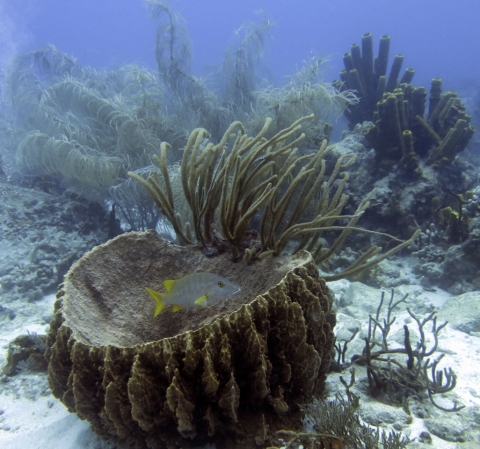
*Contamination of marine fauna by chlordecone in Guadeloupe: evidence of a seaward decreasing gradient. Charlotte R. Dromard & Mathilde Guéné & Yolande Bouchon-Navaro & Soazig Lemoine & Sébastien Cordonnier & Claude Bouchon. Environ Sci Pollu Res (2017). DOI: 10.1007/s11356-017-8924-6
Chlordecone is an organochlorine pesticide, used in the Lesser Antilles from 1972 to 1993 to fight against a banana weevil. That molecule is very persistent in the natural environment and ends up in the sea with runoff waters.
The objective of the present study* is to evaluate the level of contamination in several trophic groups of marine animals according to their distance from the source of pollution.
Samples of suspended matter, macroalgae, herbivorous fishes, detrivorous crustaceans, zooplanktivorous fishes, first- and second-order of carnivorous fishes, and piscivorous fishes have been collected in two sites, located downstream the contaminated sites (Goyave and Petit- Bourg), in three marine habitats (coastal mangroves, seagrass beds located 1.5 km from the shoreline, and coral reefs at 3 km offshore). Animals collected in mangroves were the most contaminated (mean concentrations 193 μg kg−1 in Goyave and 213 μg kg−1 in Petit-Bourg).
Samples from seagrass beds presented intermediate concentrations of chlordecone (85 μg kg−1 in Goyave and 107 μg kg−1 in Petit-Bourg). Finally, samples from coral reefs were the less contaminated (71 μg kg−1 in Goyave and 74 μg kg−1 in Petit-Bourg). Reef samples, collected 3 km offshore, were two to three times less contaminated than those collected in mangroves.
Keywords: Chlordecone - Trophic food web - Inshore-offshore gradient -Marine fauna - Guadeloupe - Coral Reefs - Mangrove - Seagrass beds
Contact : Charlotte Dromard, cdromard@univ-antilles.fr
